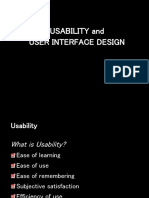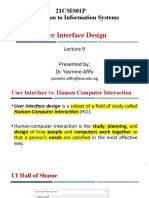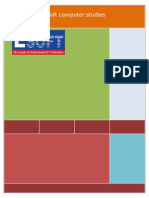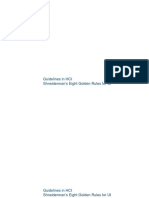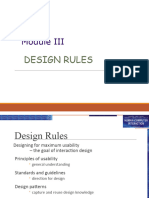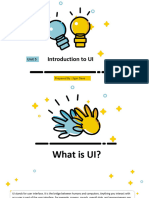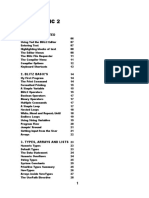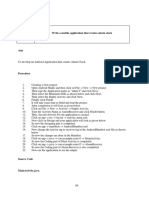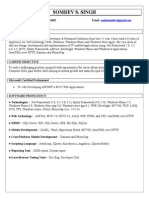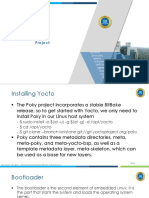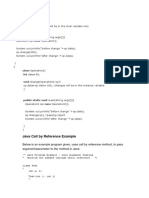11/10/19
USABILITY and
USER INTERFACE DESIGN
Click to edit Master subtitle style
1
�11/10/19
2
� 11/10/19
Usability
What is Usability?
Ease of learning
Ease of use
Ease of remembering
Subjective satisfaction
Efficiency of use
Effectiveness of use
3
� 11/10/19
What is Usability?
n How easy is it for a user of a product to achieve
his/her objectives
n Interaction between a human being and a machine
n HCI (Human-Computer Interaction)
n Usability is not restricted to computer-based products
n Usability of a procuct can be good or poor
n Often small changes in user interface can result in
much better usability:
n ”Push” sticker in a door
n Changes are often visual clues
Subcategories of Usability
n Learnability
n Memorability
n Effectiveness
n Robustness
n Enjoyability
4
� 11/10/19
Learnability/Memorability
n The ease of becoming effective for a
new user
n Similar behaviour in similar situations
n Predictability of response
n Generalizability – ability to extend current
knowledge to other situations
Effectiveness/Robustness
n Recoverability – once observed errors
are corrected
n Responsiveness – the speed of
communication
n Task completeness – System supports
users tasks as how he/she percieves
them
5
� 11/10/19
Enjoyability
n The level of satisfaction
n Very user-dependent as a concept
n Often mentioned ’Intuitive user
interface’
n Something new the resembles something
familiar
n Is based on an individual’s earlier
experiences
Usability As a Discipline
n Usability research is centered around
n Qualities that have an effect on good/poor
usability
n Methods that can be used in evaluating
product’s usability
n Methods that can be used in designing
products of good usability
6
� 11/10/19
Usability As a Discipline
n Usability is very interdisciplinary
n Psychology
n Engineering
n Arts, Linguistics
n An usability expert ?
n Traditionally resarch of usability was restricted
to user interfaces
n However many products, that had sophisticated
user interfaces failed
n Usability is also affected by qualities like
product’s structure and responsiveness
Why Usability Is Important?
n According to research usability was estimated to be
one of 6 most important skills required within
software development
n Usability is strongly connected to requirements
spesification phase of software development
n Modern development environments have made
programming work easier
n Computer-based products have become more and
more sophisticated
n Consumers have more and more products to choose
from
n Usability has become an important competitive
weapon
7
� 11/10/19
ISO 9241
n International Organization for
Standardization has defined usability as
a wholeness, which desribes
n How easily certain users can
n use tools available for them
n to perform certain tasks
n in a particular environment
Usability Engineering
Usability Engineering (UE):
Processes to build “Usability” into
products
Various methods can be used
throughout the design lifecycle
Methods can be incorporated into
design process easily
Methods maintain focus on user
throughout design
8
� 11/10/19
Why Isn’t UE Done Regularly?
Developers believe
it takes too long
is too expensive
is not critical to development
they can afford to learn about user
problems during “live” use
Also developers may not know how
to do it
Benefits of UE to an Organization
Reduce training costs
Reduce development costs
Identify and fix problems early
Reduce support costs; minimize need for
support personnel/help desks
fixes, maintenance, upgrades
Enhance organization’s reputation - positive
“word-of-mouth” trade
Larger numbers of “hit” and “return visit”
rates
9
� 11/10/19
Benefits of UE to the User
Less time to complete work
Greater success with tasks
Increased user satisfaction
Any Experience?
Typical Web-site Usability
Problems
Navigation
Knowing where you are
Finding what you want
Structure of web site
Layout
Needs sufficient white space
Use of large graphics
Computer vs Smartphone
10
� 11/10/19
User Centered Design
UCD is a dialog between the customer
and the designer
Rules of thumb:
Get to know and understand the users.
Build an application, applying usability
principles.
Test designs by observing users in a real
work setting (environment and work load).
Usability Principles
11
� 11/10/19
Mini-Exercise
Apply the principles to a web-site of your
choosing, or try:
http://www.lingscars.co.uk
http://www.leoneck.ch
Basic Principles
Assume users
Have not read the manual
Have not attended training
Do not have external help readily at hand
So…
All controls should be clear and
understandable and placed in an intuitive
location on the screen.
12
� 11/10/19
Usability Design Process
Example
13
� 11/10/19
Heuristic Evaluation
Set of guidelines for creating usable GUIs
See:
http://www.stcsig.org/usability/topics/art
icles/he-checklist.html
for a good example of a set of guidelines
as a checklist.
Interface/Dialogue Design
The team needs to worry about:
Layout (of buttons, text, table data, …)
Structuring data entry (tab order)
Controlling data input (validation and
format controls)
Feedback (prompting, status, warning,
and error messages)
Dialogue sequencing
14
� 11/10/19
GUI Design Guidelines
User in control
Consistency
Personalization & Customization
Forgiveness
Feedback
Aesthetics & Usability
Ten Golden Usability Rules
A great set of guidelines created by Jakob
Nielsen in his book Usability Engineering.
1. Use simple and natural dialog/language.
User interfaces should be simplified as much
as possible, since every additional feature or item
of information on a screen is one more thing to
learn, one more thing to misunderstand, and one
more thing to search through. And the GUI
should not overdo it with colour (= Less is more).
15
� 11/10/19
Ten Golden Usability Rules
2. Use language that fits the user group.
The language should be based on user’s
language and not on the system-oriented terms.
Translation from one language to another is more
than just words. Time, currency, phrases,
metaphors, measurements, etc. must fit the
culture of the user group.
Ten Golden Usability Rules
3. Minimise the load on short-term memory.
Users should not have to remember
information from one part of the dialogue to
another. Instructions to the use of the system
should be visible or easily retrievable whenever
appropriate.
16
� 11/10/19
Ten Golden Usability Rules
4. Make the graphical user interface coherent and
consistent.
The same action should always have the
same effect. Users will feel confident in using the
system, and they will be encouraged to try out
exploratory learning because they already have
part of the knowledge needed to operate new parts
of the system.
Ten Golden Usability Rules
5. Give the ability to use shortcuts.
Accelerators – unseen by the novices – may
often speed up the interaction for the expert’s
users, such as: function keys, command keys,
macros, etc.
17
� 11/10/19
Ten Golden Usability Rules
6. Give feedback to the user's actions.
The system should always keep users
informed about what is going on, through
appropriate feedback within reasonable time i.e.
0.1 seconds user feels the system is responding immediately;
1 s. is about the limit user’s flow of thought will stay interrupted;
10 seconds is about the limit to keep user’s attention focused on
the dialogue; so if the user has to wait longer the system should
give feedback about the waiting time.
Warning messages should be used when the
user is going to perform an irreversible action.
Ten Golden Usability Rules
7. Avoid error situations.
Ask the user if s/he really wants to do the
action especially if the action leads to serious
consequences. Avoid having too similar
commands in the interface.
Commands whose actions are opposite
should not be placed close to each other.
18
� 11/10/19
Ten Golden Usability Rules
8. Give clear exit marks.
Users often choose actions by mistake and
will need a clearly marked ”emergency exit” to
leave the unwanted state without having to go
through an extended dialogue. Cancel should be
offered when the operation will take a long time.
In the navigation bars, the users should be able
to back up.
Ten Golden Usability Rules
9. Give clear and understandable error
messages.
Simple rules for error messages:
should be phrased clearly and avoid obscure codes
messages should be precise, not vague or general
messages should constructively help the user to
solve the problem
messages should be polite and not intimidate the
user or put the blame explicitly on the user
“ILLEGAL, FATAL ACTION, JOB ABORTED!”
phrases should not be used.
19
� 11/10/19
Ten Golden Usability Rules
10. Give clear help and understandable
documentation.
Information should be easy to search, it
should be focused on the user’s task. List the
concrete steps that should be carried out. The
help manual should not be too large.
Golden Rules for Bad UIs
Interesting and amusing reading
from the SAP Design Guild:
http://www.sapdesignguild.org/commu
nity/design/golden_rules.asp
20
� 11/10/19
Usability Testing
To identify problems
Typical users perform typical tasks
Collect data
Objective: Task times, error rates
Subjective: Ratings, Comments,
Observations
Analyze data to identify usability
problems
Testing Your Application
Usability testing is ESSENTIAL to the
development process
First, navigate the application or
website yourself:
if you’re a developer, it will help you to
identify problem areas and institute
changes/corrections
if you’re doing the testing, it will provide you
with guidance about the kinds of problems
users are likely to encounter
21
� 11/10/19
Preparation
Determine who and what to evaluate
What questions do you want to
answer?
Be sure team members know their
roles
Involve a qualified person to analyze
results
Test the protocol
General Test Protocol
Introduction
Informed consent form
Training
Tasks
Questionnaire
Debriefing/Payment
22
� 11/10/19
Think-aloud Approach
Users should navigate throughout the
website and say aloud what they are
thinking and doing as they do so
Users should understand they can make
both negative and positive comments
Record all user comments
Develop an interview protocol to guide
your discussion with users
probe on issues of concern
23



